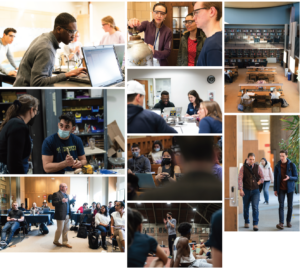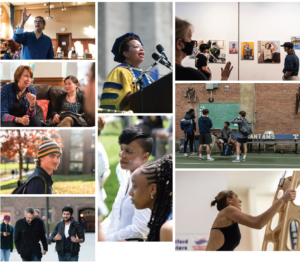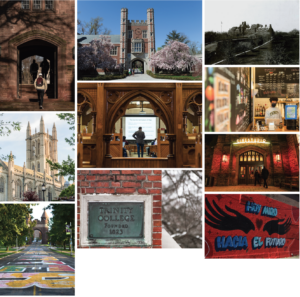Photography
Photography is a powerful tool for conveying the Trinity College brand.
Just as our story is a consequence of our people, place, and process, our photography falls into three categories. Through thoughtfully curated imagery, we tell the stories of determined doers, our dynamic location, and what we accomplish through connected community.
Learning in Action: Connected Community
 This category is all what we do at Trinity. Photos should capture people in their natural element. People are obviously essential to our connected community dynamic, but more important is what they are accomplishing together. These images should be in the moment, never posed, showcasing the amazing things our people are doing. This photographic style should capture moments of real emotion, spirit, and achievement. This can include smiles, laughter, and other positive expressions, as well as introspection and hopeful reflection.
This category is all what we do at Trinity. Photos should capture people in their natural element. People are obviously essential to our connected community dynamic, but more important is what they are accomplishing together. These images should be in the moment, never posed, showcasing the amazing things our people are doing. This photographic style should capture moments of real emotion, spirit, and achievement. This can include smiles, laughter, and other positive expressions, as well as introspection and hopeful reflection.
Images in this category reflect the experiences our students have at Trinity—moments with faculty and with each other, in and out of the classroom and on their own. These photos should feel natural, candid, and engaging, with a purposeful use of depth of field.
When selecting images that convey connected community, ask:
- Are the subjects truly engaged in their task or with each other?
- Can we reasonably tell what is being accomplished in the photo?
- Does the action captured feel authentic to Trinity and our community?
People: Determined Doers
 Our people—students, faculty, staff, alumni and members of the Hartford community—are determined doers, all. They are the driving force for what we do, as well as the audience we wish to reach. Images in this category should feel candid, natural, and in the moment, never posed or generic. Capturing a sense of curiosity, interest, or discovery is a great way to achieve this result.
Our people—students, faculty, staff, alumni and members of the Hartford community—are determined doers, all. They are the driving force for what we do, as well as the audience we wish to reach. Images in this category should feel candid, natural, and in the moment, never posed or generic. Capturing a sense of curiosity, interest, or discovery is a great way to achieve this result.
Photos in this category should express a sense of community that can only happen at Trinity. This is the chance to capture our culture as it happens during student and alumni events—on campus and around Hartford.
When choosing images of people, ask:
- Does this image reflect our community at its most vibrant and diverse?
- Is the primary subject engaged with their surroundings and fellow subjects?
- Is the photo authentic to our community?
Place: Dynamic Environment
 Location photography helps establish our setting for audiences who are new to Trinity, and reinforces it for those who are already familiar ignites offers a window into our dynamic location. These photographs represent the campus environment, the city of Hartford, and our surroundings. When scouting for these photos, look for workspaces, common areas, gathering spaces, architectures, and landscapes to help convey the wide range of studies that the Trinity community explores every day.
Location photography helps establish our setting for audiences who are new to Trinity, and reinforces it for those who are already familiar ignites offers a window into our dynamic location. These photographs represent the campus environment, the city of Hartford, and our surroundings. When scouting for these photos, look for workspaces, common areas, gathering spaces, architectures, and landscapes to help convey the wide range of studies that the Trinity community explores every day.
When taking these photos, look for unique perspectives, symmetry, depth of field, dramatic light, interesting environments, and action.
When choosing photography that compellingly conveys a sense of place, ask:
- Could this place only be Trinity College or Hartford, Connecticut?
- Will it ring true with someone familiar with our campus and Hartford?
- Would a first time visitor recognize and be excited about the place shown?
Office of Communications and Marketing
300 Summit Street
Hartford, CT 06106
